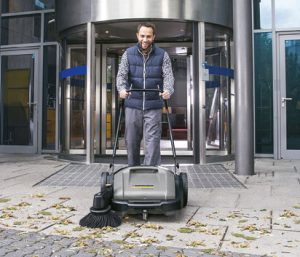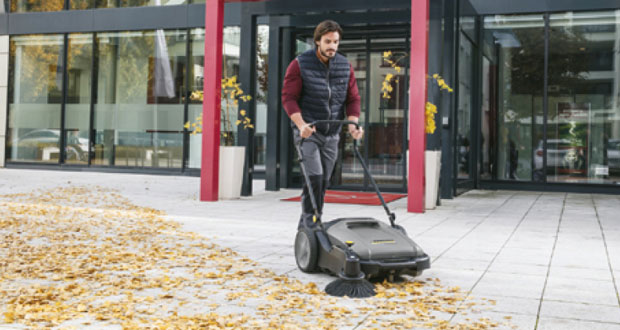Daniel Took, Head of Professional Product Marketing at Kärcher UK discusses why stopping dirt entering buildings is the most cost-effective way of maintaining both building exteriors and interiors this winter
Tackling the build-up of dirt is an everyday conundrum for FMs looking to keep premises clean and ready for use. This challenge is more prevalent during the winter months as the change in weather results in an increased amount of dirt that can be brought into facilities. As dirt is brought in from outside, it becomes embedded into flooring and stuck to surfaces, increasing the amount of time and money that needs to be dedicated to indoor cleaning.
Preventing soils from entering the facility is an often-overlooked cleaning function, however it is the most cost-effective step in tackling dirt. On average 80-94 per cent of soil tracked into a facility is brought in by foot, making it important to focus on preventing outside pollutants from entering clean and healthy indoor environments. Focusing on reducing the number of pollutants in the Preventative stage of the PDIR (Preventative, Daily, Interim, and Restorative) cleaning method will help to reduce labour and detergent costs and in turn overall running costs.
CLEAN SWEEP
Taking an outside-in approach involves starting where soils originate such as, exterior areas including parking facilities, pavements, and courtyards that users pass through on their way inside. Without maintenance these high footfall areas could result in vast amounts of dirt entering the facility, increasing the amount of time that needs to be spent deep-cleaning to provide a clean environment for users. With growing demands being placed on facilities managers to ensure that buildings are safe for users, focusing outwards-in is an efficient and productive solution to expedite the cleaning process without compromising standards.
An effective solution for tackling dirt outdoors is to make use of different equipment to help increase efficiency. For instance, while litter picking and raking leaves are effective in removing unwanted debris, utilising a vacuum sweeper instead can greatly increase cleaning productivity. Vacuum sweepers are ideal for cleaning pathways and roadways by using a combination of roller brushes and side brushes to get close to buildings and kerbs, dislodging any debris that may be stuck to the surface. The dirt is then picked up by the built-in suction fan and stored in the onboard waste container.
Overall, this provides an enhanced clean of the outdoor facilities in a fraction of the time it would take to manually collect any unwanted debris that may have built-up. Additionally, the increased variety of machines now available enables FMs to select the right machine for their needs. It is recommended that walk-behind sweepers are used when cleaning courtyards and pathways due to their smaller size and greater manoeuvrability. For larger areas, ride-on vacuum sweepers are effective due to their larger on-board waste tanks, enabling the user to cover a wider surface area with each clean.
 Incorporating outside vacuum sweeping into a structured cleaning programme will significantly reduce the number of soils that can be trafficked into the building. While getting used to adjusting the programme to focus on increased external cleaning may take some time, the overall reduction in indoor cleaning times and detergents used will make it worthwhile from a cost perspective.
Incorporating outside vacuum sweeping into a structured cleaning programme will significantly reduce the number of soils that can be trafficked into the building. While getting used to adjusting the programme to focus on increased external cleaning may take some time, the overall reduction in indoor cleaning times and detergents used will make it worthwhile from a cost perspective.
ECO EQUIPMENT
Whilst vacuum sweepers are ideal for lifting debris off the surface, making use of pressure washers will help to swiftly eradicate unwanted surface materials by dislodging dirt from crevices where they may build up over time. Selecting which type of pressure washer to use will depend on the amount of dirt that is present. For those who are time poor, hot water pressure washers could be most suited as the hot water quickly loosens and dissolves dirt, solidified oils and fats saving up to 35 per cent cleaning time when compared to cold water pressure washers.
With increased focuses on sustainable cleaning practices, facilities managers should look to make use of equipment that features eco-friendly settings. For instance, Kärcher has introduced the eco!efficiency mode across a wide range of its products, including vacuum sweepers and pressure washers. Eco!efficiency enables users to conserve fuel and reduce water wastage by keeping the machine within the most economical operating window. This enables users to achieve a high-quality clean by using the minimum number of resources.
Making use of effective machinery outdoors, just as facilities managers would indoors, will go a long way to reducing overall cleaning times. There may be costs involved in purchasing equipment for the first time – although hire options can help negate some of these costs – but the overall saving to the user will be substantial. Tackling dirt outside will greatly reduce the amount of dirt that comes into the building, helping to reduce the need for intensive deep cleaning and the added disruption that causes for facilities users.
The main aim for any FM is to ensure that their facility is a clean environment for users. From its appearance to air quality, soils that enter facilities greatly impact building cleanliness and need to be effectively eradicated to support facilities users. When it comes to tackling dirt this winter, start by looking outwards-in for the most efficient and cost-effective cleaning.





